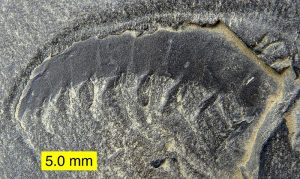The Phylum Arthropoda is extraordinarily diverse. These are the animals that will inherit the world, if they haven’t already. Let’s first visit the wonderful and arthropod-rich Burgess Shale, courtesy of the Burgess Shale Geoscience Foundation. (Eight years ago I had my own visit to the Burgess Shale at the Walcott Quarry. Magnificent!) For serious work we hardly need to stray from the arthropod pages at Berkeley and the arthropod Wikipedia page. Please visit the Berkeley onychophoran page for a look at primitive arthropod characters. The trilobite pages are especially well organized. Concentrate on the agnostids and the polymerids (the redlichiids and phacopids being important here for us) An amateur paleontologist (Sam Gon III) has an excellent Guide to the Orders of Trilobites. We will not recognize all the orders, but the images and descriptions here are tremendous. You will also find excellent images of trilobites on the Wikipedia trilobite page. The most comprehensive set of trilobite images is courtesy of the American Museum of Natural History. We now have excellent evidence for trilobite eggs.
An excellent “eurypteridology” website is maintained by Samuel J. Ciurca, Jr. Katherine Marenco at Bryn Mawr (and a Wooster geology alumna) found this Eurypterid Tumblr page. To complete your set, please visit websites for the crustaceans, insects and arachnids.
You’re too young to remember the bizarre Sea Monkeys craze. It was based on the real science of brine shrimp and cryptobiosis. Who knew the story also involves racism and the KKK?
Thought you might like to see this YouTube video on the fossils below the Creation Museum in northern Kentucky. They will be familiar! You may want to see the related videos, like this one on Cincinnatian fossils. You can watch people digging for trilobites for fun and, apparently, profit. You get to do it for free!

Anomalocaridid “arm” from the Burgess Shale (Middle Cambrian), Walcott Quarry, British Columbia, Canada.
Geology in the News –
Mount Etna, Europe’s most active volcano, is slowly sliding into the sea. The fear is it could catastrophically collapse, producing massive tsunamis. (I’ve been on its slopes, by the way. Fantastic place.)
Check out this story (and book) about the illegal trade in dinosaur bones. I’m pleased to see there are serious penalties for stealing from the public — and from science itself.
The end-Cretaceous asteroid impact may have had an even more dramatic effect on climate than we thought (and that was pretty bad). I notice here that the asteroid is now expanded from 10 to 12 km in diameter. Here’s a BBC account of the same research.
